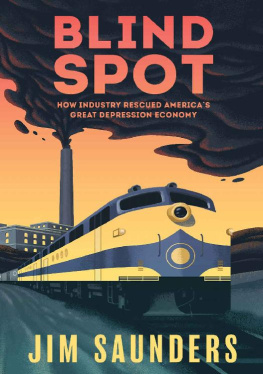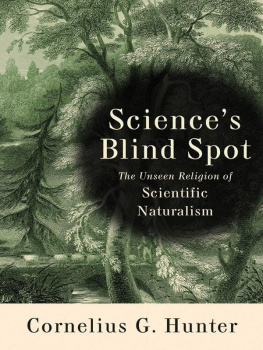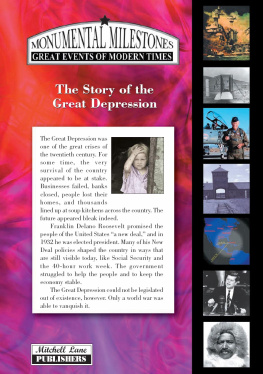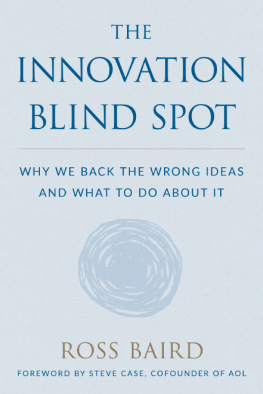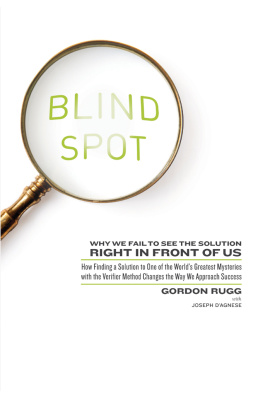Jim Saunders - Blind Spot: How Industry Rescued Americas Great Depression Economy
Here you can read online Jim Saunders - Blind Spot: How Industry Rescued Americas Great Depression Economy full text of the book (entire story) in english for free. Download pdf and epub, get meaning, cover and reviews about this ebook. year: 2020, genre: Science. Description of the work, (preface) as well as reviews are available. Best literature library LitArk.com created for fans of good reading and offers a wide selection of genres:
Romance novel
Science fiction
Adventure
Detective
Science
History
Home and family
Prose
Art
Politics
Computer
Non-fiction
Religion
Business
Children
Humor
Choose a favorite category and find really read worthwhile books. Enjoy immersion in the world of imagination, feel the emotions of the characters or learn something new for yourself, make an fascinating discovery.
- Book:Blind Spot: How Industry Rescued Americas Great Depression Economy
- Author:
- Genre:
- Year:2020
- Rating:4 / 5
- Favourites:Add to favourites
- Your mark:
- 80
- 1
- 2
- 3
- 4
- 5
Blind Spot: How Industry Rescued Americas Great Depression Economy: summary, description and annotation
We offer to read an annotation, description, summary or preface (depends on what the author of the book "Blind Spot: How Industry Rescued Americas Great Depression Economy" wrote himself). If you haven't found the necessary information about the book — write in the comments, we will try to find it.
Jim Saunders: author's other books
Who wrote Blind Spot: How Industry Rescued Americas Great Depression Economy? Find out the surname, the name of the author of the book and a list of all author's works by series.
Blind Spot: How Industry Rescued Americas Great Depression Economy — read online for free the complete book (whole text) full work
Below is the text of the book, divided by pages. System saving the place of the last page read, allows you to conveniently read the book "Blind Spot: How Industry Rescued Americas Great Depression Economy" online for free, without having to search again every time where you left off. Put a bookmark, and you can go to the page where you finished reading at any time.
Font size:
Interval:
Bookmark:
BLIND SPOT
How Industry Rescued Americas Great Depression Economy
Jim Saunders
Copyright 2020 by Jim Saunders. All Rights Reserved.
Copyright 2020 by Jim Saunders
No part of this publication may be reproduced, distributed, or transmitted in any form or by any means, including photocopying, recording, or other electronic or mechanical methods, or by any information storage and retrieval system without the prior written permission of the publisher, except in the case of very brief quotations embodied in critical reviews and certain other noncommercial uses permitted by copyright law.
E-book ISBN 978-1-7348624-1-6
Contents
Chapter 2
Photographer Dorothea Langes famous photograph of Migrant Mother Courtesy, Farm Security Administration-Office of War Information. LoC C/N, 2017762891
Red cross serving beverages to men Courtesy, Farm Security Administration-Office of War Information. LoC C/N, 2016879103
People living in miserable poverty Courtesy, Farm Security Administration-Office of War Information. LoC C/N, 2017763118
Squatters along highway near Bakersfield Courtesy, Farm Security Administration-Office of War Information. LoC C/N, 2017759223
Chapter 4
Part carnival side show-part valuable research Courtesy, Manuscripts and Archives Division, The New York Public Library. Infant Incubator Woman looking at babies in incubators. Image ID, 1675847
General Motors Futurama Courtesy, Manuscripts and Archives Division, New York Public Library. General Motors Futurama Visitors in moving chairs viewing exhibit. Image, ID 1674373
Pontiac transparent ghost car Courtesy, Manuscripts and Archives Division, New York Public Library. General Motors Crowd viewing transparent car at dedication. Image ID, 1674229
RCA Television Courtesy, Manuscript and Archives Division, New York Public Library. Radio Corporation of America (RCA) Harvey Gibson, Miss Television, and James E. Robert standing with television Image ID, 1681015
Miss Chemistry Courtesy, Hagley Museum and Library Miss Chemistry models nylon stockings at the New York Worlds Fair. Image ID, 1984259_121412_013
Elektro and Sparko Courtesy, Manuscript and Archives Division, New York Public Library. Westinghouse Mechanical Man and Dog (Elektro and Sparko) Image ID 1686391
Theme Center Courtesy, Manuscript and Archives Division, New York Public Library. Theme Center Trylon and Perisphere View of Trylon and Perisphere with sculpture, fountains, man and woman in foreground Image ID 1684531
Chapter 7
Jedidiah Strutt 18 th century cotton mill. Courtesy, Wikimedia Commons scanned from 1819 Rees Cyclopedia
Chapter 11
1913 Ford Model T Courtesy, The National Museum of American History, Smithsonian Institution. ID No . TR.311052
Chapter 12
With Orville Wright at the controls. Courtesy, Smithsonian Air and Space Museum, Smithsonian Institution. ID SI2003-3463
U. S. Army Air Mail Curtiss JN-4HM Courtesy, Smithsonian Air and Space Museum, Smithsonian Institution. ID 2000-6150
White I-30 Tractor Pulling Ford Tri-Motor Airplane Courtesy, Wisconsin Historical Society. image ID 7213
Chapter 13
Doctor Onsgard harvesting Courtesy, Fillmore County Historical society, https://reflections.mndigital.org /fch:189
Chapter 16
Ball Bearing Courtesy, Grayhawk Press
Tapered roller bearing Courtesy, Grayhawk Press
Chapter 18
Machine shop classroom Courtesy, Wisconsin Historical Society. image ID 7952
Chapter 27
Armory, Columbus, Ohio Courtesy Library of Congress Detroit Publishing Company. 2016803777
Chapter 33
General Motors Turret Top Promotion. GM Media Archives. Image No. 211248
1939 Ford DeLuxe Courtesy, The Henry Ford . ID THF90290
Transportation to Fair Women with car and trailer . Courtesy, Manuscript and Archives Division, New York Public Library. Image ID 1685005
Chapter 34
International 1939 D-Line Truck Courtesy, Wisconsin Historical Society. image ID 122108
Semi-tractor with 5th wheel-1939. Courtesy, Farm Security Administration Office of War Information. LoC C/N 2017719135
International D-300 Truck Courtesy, Wisconsin Historical Society. image ID 121289
Greyhound Lines bus-1937. Courtesy, Library of Congress https://lccn.loc.gov/2016878403
Pre-war Kenworth Fire Truck. MOHAI, Courtesy, Museum of History and Industry. 1983.10.14407.3
Milkman in front of Divco MOHAI, Courtesy, Museum of History and Industry. 1983.10.13902.1
A driver sits in an International truck TiltTop Bottle Capper-1929. Courtesy, Wisconsin Historical Society. image ID 49202
Chapter 35
Elevated view of group of men and women boarding an American Airlines Courtesy, Wisconsin Historical Society Image ID:62924
Chapter 36
Empty cans are filled with peas Courtesy, Farm Security Administration-Office of War Information. LoC C/N 2017780255/
A ten-arm Owens automatic bottle machine, ca. 1913. Courtesy, Lewis Hine
Placing packaged goods on display rack Courtesy, Farm Security Administration-Office of War Information. LoC C/N 2017785132
Chapter 40
A Wendy Welder Courtesy, U.S. Office of War Information. LoC C/N 2017697447
Chapter 48
GM 1947 Electromotive F-Series Astra Liner Courtesy, General Motors Archives. ID Number 166158
Chapter 49
Bulldozer used in grading during the construction Courtesy, Farm Security Administration-Office of War Information. LoC C/N, 2017871713
Laying sidewalks with grader at New York Worlds Fair-1939. Courtesy, Manuscript and Archives Division, New York Public Library. Image ID 1675481
Chapter 50
1946 catalog illustration of an International Harvester Farmall HV tractor. Courtesy, Wisconsin Historical Society. Image ID: 28761
Chapter 51
Ford Model A Courtesy, The Henry Ford. ID THF120026
1949 Ford Tudor sedan Courtesy, The Henry Ford. ID THF90472
Chapter 52
O-ring. Courtesy, Grayhawk Press
Chapter 54
A window display at the Wisconsin Power Courtesy, Wisconsin Historical Society. Image ID 73462
Testing a Westinghouse refrigerator-1937. Courtesy, Wisconsin Historical Society Image ID . 14963
1947 International Harvester refrigerator. Courtesy, Wisconsin Historical Society Image ID . 12017
Saleswoman demonstrating a Maytag washing machine to a customer (1937). Courtesy, Wisconsin Historical Society. Image ID 14889
The Bendix Home Laundry was a homemakers dream Courtesy, MOHAI Museum of History and Industry. 1983.10.15984.2
T he Great Depression ranks as one of American historys most scrutinized events. Only the Civil War and World War II hold more historical interest than this 1930s catastrophe. Ninety years later, its story has all the elements of a classic thriller. For more than a decade, the tale of Americas infamous economic panic provided a diverse collection of hardworking underdogs, flamboyant protagonists, and loathed antagonists. The plot contains several dramatic twists, while the tremendous recovery led to an extraordinary feel-good ending. Yet, two controversial mysteries remain unresolved: What caused the Great Depression? Did World War II spending drive the recovery?
Mainstream scholarship suggests that academia has a lock on those answers: a cataclysmic failure of capitalism caused the Great Depression; the New Deal offered some relief; and finally, massive World War II military spending rejuvenated the still-sluggish economy.
Yet, the debate trudges on and at times intensifies as disenfranchised academics and enthusiasts challenge the establishments view of the panic years.
One indisputable Great Depression truth is the scale of the economic damage endured by Americans during the 1930s and into the 1940s. The unemployment rate between 1931 and 1940 peaked at 25% and never dropped much below 15%. In the first few years, a third of Americas banks closed. When the economy struck bottom, many of the nations business sectors revenues dropped by 50%. Then came the war. Nearly 400,000 Americans died in combat during World War II, with total casualties exceeding one million. Back home, civilians lived with widespread shortages and harsh rationing. Even the post-war recovery turned into a multi-year struggle.
Font size:
Interval:
Bookmark:
Similar books «Blind Spot: How Industry Rescued Americas Great Depression Economy»
Look at similar books to Blind Spot: How Industry Rescued Americas Great Depression Economy. We have selected literature similar in name and meaning in the hope of providing readers with more options to find new, interesting, not yet read works.
Discussion, reviews of the book Blind Spot: How Industry Rescued Americas Great Depression Economy and just readers' own opinions. Leave your comments, write what you think about the work, its meaning or the main characters. Specify what exactly you liked and what you didn't like, and why you think so.

